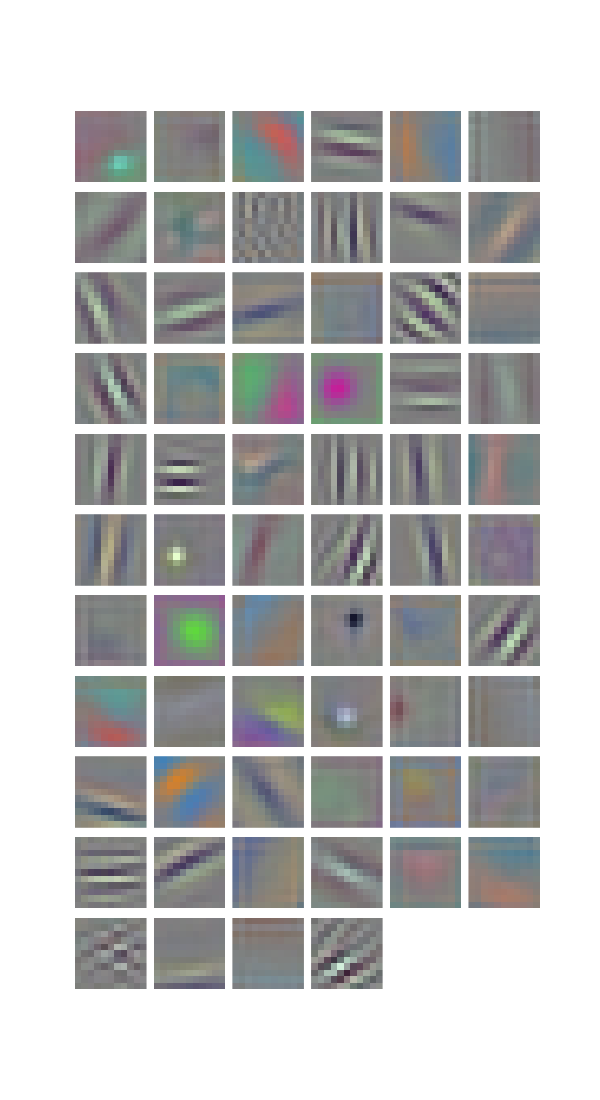Hi,
I’m trying to plot the kernels in my first layer but they don’t look right.
I used a pre trained AlexNet and there’s definitely structure but the colours seem off.
Here is a fairly minimal example:
import torchvision.models as models
import torchvision.transforms as transforms
import torch.nn as nn
import torch
import matplotlib
matplotlib.use('Agg')
import matplotlib.pyplot as plt
def plot_kernels(tensor, num_cols=6):
num_rows = 11
fig = plt.figure(figsize=(num_cols,num_rows))
i = 0
for t in tensor:
ax1 = fig.add_subplot(num_rows,num_cols,i+1)
pilTrans = transforms.ToPILImage()
pilImg = pilTrans(t)
ax1.imshow(pilImg, interpolation='none')
print(tensor[i])
ax1.axis('off')
ax1.set_xticklabels([])
ax1.set_yticklabels([])
i+=1
plt.subplots_adjust(wspace=0.1, hspace=0.1)
plt.show()
alexnet = models.alexnet(pretrained=True)
i = 0
for m in alexnet.modules():
if isinstance(m, nn.Conv2d):
if i == 0:
plot_kernels(m.weight.data.clone().cpu())
plt.savefig('result.png')
Which results in:
So I guess it has something to do with the structure so I produced this example:
import torchvision.models as models
import torchvision.transforms as transforms
import torch.nn as nn
import torch
import matplotlib
matplotlib.use('Agg')
import matplotlib.pyplot as plt
def plot_kernels(tensor, num_cols=6):
num_rows = 1
fig = plt.figure(figsize=(num_cols,num_rows))
i = 0
for t in tensor:
ax1 = fig.add_subplot(num_rows,num_cols,i+1)
pilTrans = transforms.ToPILImage()
pilImg = pilTrans(t)
ax1.imshow(pilImg, interpolation='none')
ax1.axis('off')
ax1.set_xticklabels([])
ax1.set_yticklabels([])
i+=1
plt.subplots_adjust(wspace=0.1, hspace=0.1)
plt.show()
tensor = torch.FloatTensor([[
[[0, 0, 0], [0, 0, 0], [0,0,0]], [[0, 0, 0], [0, 0, 0], [0,0,0]], [[1, 1, 1], [1, 1, 1], [1,1,1]],
[[0, 0, 0], [0, 0, 0], [0,0,0]], [[0, 0, 0], [0, 0, 0], [0,0,0]], [[1, 1, 1], [1, 1, 1], [1,1,1]],
[[0, 0, 0], [0, 0, 0], [0,0,0]], [[0, 0, 0], [0, 0, 0], [0,0,0]], [[1, 1, 1], [1, 1, 1], [1,1,1]],
],[
[[1, 1, 1], [1, 1, 1], [1,1,1]], [[0, 0, 0], [0, 0, 0], [0,0,0]], [[0, 0, 0], [0, 0, 0], [0,0,0]],
[[0, 0, 0], [0, 0, 0], [0,0,0]], [[1, 1, 1], [1, 1, 1], [1,1,1]], [[0, 0, 0], [0, 0, 0], [0,0,0]],
[[0, 0, 0], [0, 0, 0], [0,0,0]], [[0, 0, 0], [0, 0, 0], [0,0,0]], [[1, 1, 1], [1, 1, 1], [1,1,1]]
],
])
plot_kernels(tensor)
plt.savefig('result.png')
Which produces this result: (I can’t post a second image as I’m a new user ![]() )
)
I guess I expected a blue square and then either a black square with a white diagonal? What I get is vertical stripes of red, green then blue. I could see how they might be horizontal instead but I didn’t expect vertical ones?
Is this the right way to save the weights to look at their structure? How can I plot these weights with accurate colour?
Thanks!

